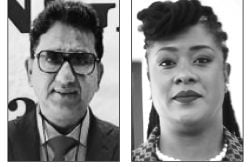By Dionne Frank
Just over six weeks ago, Guyanese were captivated by the circulation of a series of videos on social media platforms showing a young lady, who despite appearing to withdraw her consent continued to be sexually abused by two men. Days later, the main perpetrator’s body was discovered on the Kitty foreshore. These events evoked outrage as well as apathy in some quarters. Conversely, much of the discussions and debates focused on the character and age of the victim, the nature of the sexual encounter, and the subsequent demise of the main perpetrator. Citizens also used social media to promote the main perpetrator’s death (be it by suicide or homicide) as a justifiable form of punishment, and a deterrent for others who demonstrate a proclivity for sexual depravity.
Apart from the nature of the abuse and the irresponsible comments about the victim’s character, what stood out for me during this period was the observation of people, inclusive of many professionals requesting of and/or encouraging social media personalities to share the videos. Clearly, no thought was given for the wellbeing of the victim or the implications enshrined in the Cybercrime Act for anyone who transmits child pornography. I was also taken aback by the lack of tact and ethical judgment, and the insensitivity evident in the indiscrete requests for access to the videos. These ethical concerns, however, collectively constitute a microcosm of a larger challenge confronting various professions with the evolution of social media.
Accordingly, I am using this case to highlight the possible consequences of social media misuse, the threat it poses to one’s professional identity, and as a call to action. While this problem is not confined to a specific discipline, I will limit my observations to social work.
According to the International Association of Schools of Social Work (IASSW) and the International Federation of Social Workers (IFSW), “Social work is a practice-based profession and an academic discipline that promotes social change and development, social cohesion, and the empowerment and liberation of people. Principles of social justice, human rights, collective responsibility and respect for diversities are central to social work. Underpinned by theories of social work, social sciences, humanities and indigenous knowledge, social work engages people and structures to address life challenges and enhance wellbeing….”
Explicitly embedded in this definition of the profession are the values it embraces, and the recognition that specialised skills, knowledge, and practice experience are necessary to perform the identified functions.
By virtue of their exposure to the knowledge base, and values underpinning the training, there should be no professional social worker who is ignorant of the ethical codes of the profession and therefore risks violating them.
If one were to ask professionals why they requested, shared, or encouraged others to view the video recordings in question, likely responses would include seeking justice for the victim. Since the story had made headlines in several online and print publications, that response could be deemed indefensible. In an ideal practice landscape however, the only people making request for access to, and with whom the videos should have been shared are the police, the Director of the Childcare and Protection Agency, and the practitioner(s) assigned to the case. This practice aligns with the values and principles of the profession. Therefore, to expand the circle of those with whom the recordings were shared, is a clear violation of social work ethics and values.
Undoubtedly, social media and other online fora have transformed the communication landscape, facilitating the engagement of social work professionals with service users via multiple networks. It has also widened the scope to share information pertaining to services, and tools to assist people to enhance their lives. Contrastingly, the misuse of social media has negative consequences.
While the impact on the victim of the sexual abuse and the subsequent circulation of the videos is not known, here is a possibility: The indignity brought about by the violation of the young lady is sufficient to drive her to commit suicide. Fortunately, that did not happen but the victim now has limited options to avoid facing friends and relatives after her dehumanising experience.
In our connected world, information shared via social media can go viral in mere minutes. Therefore, sharing sensitive video recordings of the victim also increased her vulnerability, and placed her at further risk for exploitation. For these and more reasons, I trust that the relevant social agencies have facilitated an intervention for the victim to assist her in processing the traumatic experience.
Beyond the unintentional harm to victims/clients that may occur as a consequence of professionals’ tactlessness on social media platforms, there is also the compromised reputation of the professional. Some social workers may not view this as a threat to their reputation, but the public is likely to lose confidence in social workers/agencies because of the fear that their issues/problems will be similarly shared with others when they seek assistance.
There are also implications for social work as a field of practice. This is simply because while there are some key attributes of the profession, such as social work education, the knowledge base, and a professional organisation in Guyana, there is no regulatory legislation which is critical to its full public recognition and autonomy.
Consequently, professionals’ tactless interaction on social media, as evidenced by their requests to access and share the videos, undermines the limited public recognition that social work has achieved. Basically, if there are disparities between the defined values and ethics embodied in the profession and the noticeable actions of personnel who received the training, the credibility of the profession will be questioned. This problem is not unique to Guyana, but is compounded by a powerless fraternal association, whose active members comprise less than two percent (2%) of the social work graduates produced by the University of Guyana.
Additionally, cynics will always question the credibility of the profession’s contribution to social change if social workers themselves continuously demonstrate a lack of ethical judgment, and adherence to codes. This will also create confusion in the minds of others, particularly when the aim is to protect vulnerable people; it is obvious from professionals’ tactless behaviour on social media that their actions can result in the opposite.
For these reasons, I trust that practitioners will understand that after seventy-four (74) years of practice, forty-seven years (47) of training, and thirty-eight years of fraternal association, social work’s professional identity in Guyana remains fragile and is the basis of recent efforts to introduce a regulatory framework. Consequently, individually and collectively advocates of the profession must be mindful of the threats to its fragile professional identity.
This case involving the circulation of videos showing sensitive content is unlikely to be the last, particularly in an evolving culture where images/videos of injured people and dead bodies at accident scenes are shared with no thought for the privacy of victims, and the feelings of relatives. However, regardless of whether you are a professional or layperson, everyone should take some form of action to contain the spread inappropriate videos/images on social media. A simple solution would be to let others know of their misuse of social media, however, more is required.
My expectation, therefore, is that when professionals or laypeople have access to similar videos, they must first seek to do no harm to others by only sharing them with the police, who have the mandate to investigate, protect the victim, and persecute the perpetrator(s). Once a child is involved, the case must be reported to the Childcare and Protection Agency, whose work is supported by legislation which give the agency the authority to intervene when the best interest of a child is compromised.
Teachers who learn of such situations should use them as teachable moments to enlighten students about potential dangers of their actions, as well as to deter them from doing likewise. However, parents, community, religious and youth leaders also have an obligation to share this burden, and to adopt similar approaches.
More importantly, it is also time for public service announcements to enlighten the nation’s people about the implications of social media use and misuse.
Dionne Frank is a lecturer in Social Work in the Department of Sociology, in the Faculty of Social Sciences at the University of Guyana.




